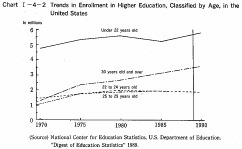| Home > Policy > White Paper, Notice, Announcement > White Paper > JAPAMESE GOVERNMENT POLICIES IN EDUCATION,SCIENCE AND CULTURE 1990 > PART |
||
Higher education in the United States is characterized by the diversity of its structures and programs and by the vastness of its scale.
American institutions of higher education may be classified into two groups: four-year institutions and junior colleges. Four-year institutions may be further classified into the following three groups:
1).Universities??Universities are composed of several colleges and schools providing general and professional education. They are of relatively large size and stress education and research at the postgraduate level.
2).Liberal arts co1leges??Liberal arts colleges are four-year institutions placing emphasis on general education and specialized education in the fields of the humanities and sciences. In recent years they have strengthened their function of offering preparatory courses for advanced studies available in universities and professional schools.
3).Professional schools??Professional schools aim at training professional workers in the fields of engineering, agriculture, medicine, business administration, teacher training, and so forth.
Junior colleges offer either general or vocational education usually for two years. They aim at providing an education equivalent to that offered in the two-year lower division of four-year college and terminal education (stressing vocational education and training). Public junior colleges are usually called "community colleges." providing at low cost a wide range of courses adapted to the needs of students.
The higher education age population (aged 18 to 24) recorded a dramatic increase during the 1960's and the 1970's. However, it has been decreasing since 1981 and is projected to remain almost even during the 199O's. The population aged18 is also anticipated to show a similar trend. However it is expected to increase in and after 1995.
Enrollment in higher education has continued to increase, with
varied rates of increase, since the 1960's. It tripled from 4.100,COO in 1961
to 12.800.000 in 1987.This increase was due to various factors, including: the
creation of Federal grants to veterans after World War ![]() ; an increase in the
relevant age group caused by the post-war baby boom; and especially, a notable
increase in the proportion of the age group advancing to higher education during
the 1960's. An analysis of the recent age range of higher education students
reveals that an increase in the number of adult students has been offsetting
the decrease in the higher education age group.
; an increase in the
relevant age group caused by the post-war baby boom; and especially, a notable
increase in the proportion of the age group advancing to higher education during
the 1960's. An analysis of the recent age range of higher education students
reveals that an increase in the number of adult students has been offsetting
the decrease in the higher education age group.
As shown in Chart ![]() -4-2, an increase in the number of "non-traditional" students
aged 22 or more, especially students aged 30 or more, has been offsetting the
decrease in the number of "traditional" younger students, and sustaining the
expansion of enrollment in higher education.
-4-2, an increase in the number of "non-traditional" students
aged 22 or more, especially students aged 30 or more, has been offsetting the
decrease in the number of "traditional" younger students, and sustaining the
expansion of enrollment in higher education.

The greater majority of non-traditional students are enrolled in colleges with diverse modes of part-time attendance, including attendance on weekends and during vacations. The numbed of part-time students accounted for 43% of all students in 1986.
In 1986 the total number of institutions of higher education was approximately 3,400, and total enrollment therein was approximately 12,500,000. (Of this total, about 4,680,000 were enrolled in junior colleges.) The number of private institutions accounted for about 55% of all institutions, while enrollment in these institutions represented only about 22% of the total enrollment. In general, private institutions are of smaller size than public ones.
About one-third of all institutions of higher education in the United States are junior colleges. The number of these colleges has doubled during the past 25 years. Most of them are publicly controlled.
The educational reform movements, which aimed at reforming secondary education at the start and have recently been extending to higher education, have defined their agreed target as the qualitative improvement of education. Accordingly, at the higher education level, emphasis is placed on efforts to enhance the quality of college education and to ensure excellence in higher education by means of strictly assessing and evaluating what additional values individual students have acquired during their college life, and by means of innovations in the curriculum so as to adapt it to a changing society.
With regard to the qualitative change of education, the following points have been pointed out as policies to be considered: that attention should be paid to secure better articulation between secondary and higher education so as to improve the level of scholastic achievement of high school students who wish to enter college; that the concept of public service should be incorporated into higher education programs; that in the light of the rapid change in the racial and ethnic composition of the population in the United States, higher education students who belong to minority groups, especially Blacks and Hispanics, should be increased so that the proportion of these students may be closer to the proportion of the total population who belong to minorities; that the number of holders of higher degrees should be increased in key disciplines, especially in engineering with a view to helping improve the scientific and technological standards of the nation; and that students' foreign language proficiency should be improved.
| Back to Top | MEXT HOME |